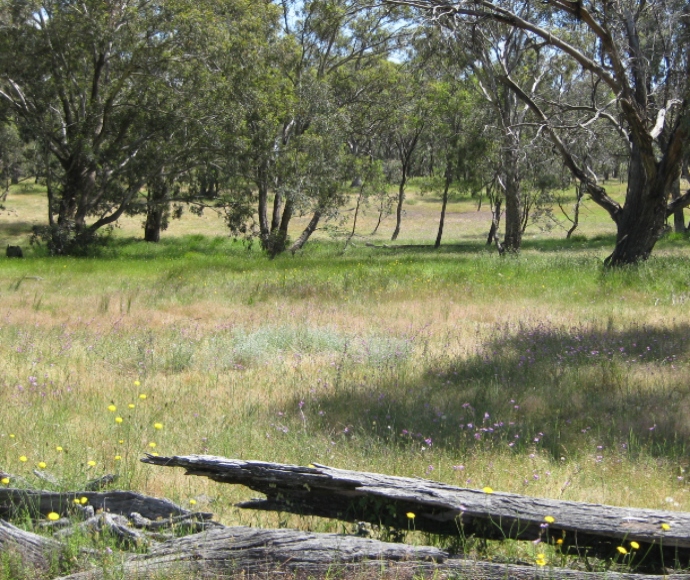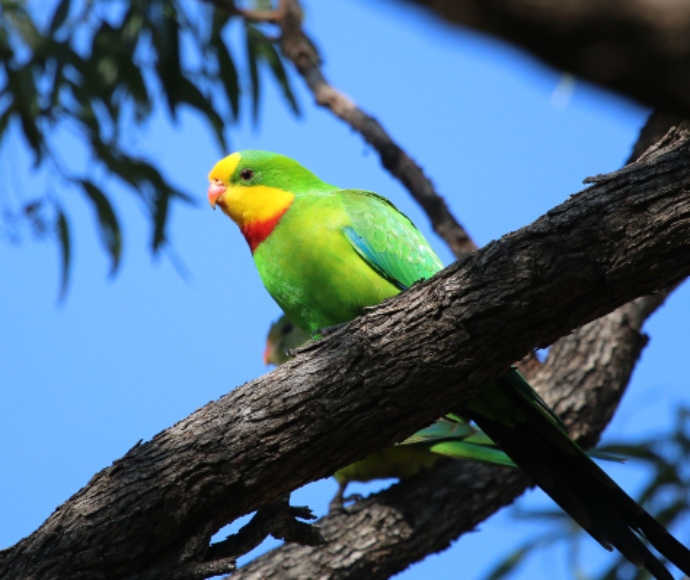Looking after box-gum woodland
Box-gum woodland is a critically endangered ecological community that supports a significant diversity of plant and animal species, including many threatened species. Although this ecological community was once widespread from southern Queensland to Victoria, it is estimated that only 5 per cent remains today. Together, let’s protect and restore box-gum woodland for all the species that depend on it.
Box-gum woodland is characterised by a canopy of widely spaced eucalypt trees such as white box (Eucalyptus albens), yellow box (Eucalyptus melliodora) and Blakely’s red gum (Eucalyptus blakelyi) with a diverse mix of native tussock grasses and herbs and a sparse shrub layer. Box-gum woodland is also known as white box–yellow box–Blakely’s red gum grassy woodland and derived native grassland.
Although box-gum woodland was once widespread, the fertile foot slopes and flats west of the Great Dividing Range that support box-gum woodland were generally preferred for cropping, pasture and infrastructure development. As a result, much of the woodland has been removed, persisting as fragments or ‘remnants’ of varying quality scattered throughout the landscape.
These remnants are critical to the survival of the species adapted to occur in these landscapes, and many are still being lost due to further clearing and ongoing degradation from threats such as weed invasion, overgrazing, nutrient imbalances, inappropriate fire regimes and feral herbivores. For these reasons, box-gum woodland is listed as a critically endangered ecological community (CEEC) under the Biodiversity Conservation Act 2016.

Across New South Wales, box-gum woodland provides important habitat for diverse plants and animals, including mammals, birds, reptiles, frogs and countless invertebrates.
Many species depend on the availability of high-quality box-gum woodland where there are large, older trees with hollows, woody debris or connectivity to larger remnants across the landscape. Sadly, many of these species are listed as threatened, including the spotted-tailed quoll (Dasyurus maculatus), squirrel glider (Petaurus norfolcensis), regent honeyeater (Anthochaera phrygia) and superb parrot (Polytelis swainsonii).
Nearly 400 threatened plant and animal species are found in grassy woodlands, of which box-gum woodland is a major component. You can explore Species found in the grassy woodlands formation on our website. Don’t forget to use the left pane to filter the list by the region you live in.

The following list of key questions will help you identify an area of box-gum woodland:
- Does the site contain, or did it contain prior to disturbance, white box, yellow box or Blakely’s red gum?
- Is the ground layer mainly grassy?
- If the site has been degraded, is there potential for assisted natural regeneration of the tree layer or the understorey (for example, by removing grazing or weeds)?
If you answer yes to these questions and the area is in the region shown in the map below (the NSW North Coast, New England Tableland, Nandewar, Brigalow Belt South, Sydney Basin, South Eastern Highlands, South Western Slopes, South East Corner and/or Riverina bioregions of New South Wales), the area is probably box-gum woodland.
For more detailed information, refer to the NSW Threatened Species Scientific Committee’s Final Determination, the Australian Government’s Species Profile and Threats Database or the NSW Government’s threatened species profile page.

If you have the good fortune to own a patch of critically endangered box-gum woodland on your property, it is testament to your good management and those who managed the land before you! The remnant is likely to have significant value and is worth maintaining and managing to protect and improve its value for future generations.
As box-gum woodland is a listed critically endangered ecological community under the Biodiversity Conservation Act 2016, some management activities may also require consent or approval. Contact savingourspecies@environment.nsw.gov.au or your Local Land Services (LLS) for more information.

Managing box-gum woodland
There are currently over 100 threatened ecological communities in New South Wales. Saving our Species takes a holistic approach to conserve entire ecosystems, in turn preserving the many different species, ecological cycles and niches that exist within these ecosystems.
A targeted strategy for managing box-gum woodland has been developed under Saving our Species. Since 2016, Saving our Species has implemented actions under the strategy such as weed control, restoration planting, habitat enhancement, management of grazing and community engagement – see Box-gum woodland: Saving our Species projects 2016-21 for details.
Saving our Species also supports a range of projects for species that occur in box-gum woodland, including the Keeping up with the superb parrot citizen science project.

Protecting and restoring box-gum woodland is important for biodiversity conservation and for providing ecosystem services.
The following resources help landholders understand the best ways to improve the condition of box-gum woodland and manage remnant woodland patches:
- Australian National University’s Sustainable Farms
- Australian Government’s White Box–Yellow Box–Blakely's Red Gum Grassy Woodland and Derived Native Grassland National Recovery Plan
- NSW Government's Biodiversity Conservation Trust.
Incentives and assistance are available to land managers and Landcare groups to help protect and restore box-gum woodland.
Visit the following organisations and programs for more information:
- Saving our Species Contestable Grants Program
- NSW Environmental Trust
- NSW Government’s Biodiversity Conservation Trust.

Find out more
Read:
- BioNet Quantitative Plant Community Type classification
- PlantNET for key eucalypts: white box (Eucalyptus albens), yellow box (Eucalyptus melliodora) and Blakely’s red gum (Eucalyptus blakelyi)
- Checking for Change: A practical guide to checking whether sites newly managed for conservation are on track to improve
- State-and-transition modelling for Adaptive Management of native woodlands.
Read:
Watch:
- NSW woodlands – This video describes how to identify woodlands, where you might find them, the different ecological niches they provide and some threats to their ongoing survival.
- Threatened woodlands and plants – This video discusses ecological communities with a focus on the endangered box-gum woodland, including endangered woodland plants and some of the efforts being made to ensure they survive into the future.
- Woodland birds – This video explores many of the birds that inhabit NSW woodlands, the different feeding and nesting habitats they require and the reasons so many of our woodland birds are in trouble.
- Frogs on farms – This video explores the reasons frogs are disappearing and the efforts being made to conserve the Booroolong frog, which exists mainly on rivers and creeks in the agricultural landscape.
- Woodland mammals – This video explores the different types of mammals found in Australia, the types of mammals that historically inhabited woodlands, why so many are threatened and some activities being undertaken to prevent further extinctions.








